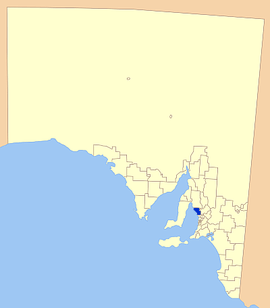District Council of Mallala
| District Council of Mallala South Australia | |||||||||||||
|---|---|---|---|---|---|---|---|---|---|---|---|---|---|
|
Location of the District Council of Mallala | |||||||||||||
| Population | 8,385 (2009)[1] | ||||||||||||
| • Density | 8.9958/km2 (23.2991/sq mi) | ||||||||||||
| Established | 1935, renamed 15 April 1937 | ||||||||||||
| Area | 932.1 km2 (359.9 sq mi) | ||||||||||||
| Mayor | Marcus Strudwicke | ||||||||||||
| Region | Barossa, Light and Lower North[2] | ||||||||||||
| Website | District Council of Mallala | ||||||||||||
| |||||||||||||
The District Council of Mallala was originally proclaimed in 1935 as the District Council of Light. It is the result of the amalgamation of the District Councils of Dublin, Port Gawler and Grace Plains. The District Council of Light was renamed the District Council of Mallala on 15 April 1937.
The first white settlement of the area dates back to the Port Gawler Special Survey in 1839. Originally the land was inhabited by the Kaurna people whose territory extended in a narrow corridor along the eastern shore of Gulf St Vincent; Cape Jervis to Port Wakefield; inland to near Crystal Brook, Snowtown, Blyth, Hoyleton, Hamley Bridge, Clarendon, Gawler, and Myponga; from the east side of the Hummock Range to Red Hill. Inland the stringy bark forests of the Mount Lofty Ranges marked their boundary.
Throughout the district large tracts of surveyed land were allotted to pastoralists who farmed mostly grain and sheep. The early produce of the area was often shipped out on ketches from the Ports of Gawler and Parham.
Both the Light River and the Gawler River pass through the district and the rich fertile plains are ideal for vegetable production, the majority of which is sent to the nearby Adelaide markets. As well as the general agricultural pursuits of grain growing and storage and running livestock, other major industries in the region include the livestock market / sale yards, metal fabrication and manufacture of industrial equipment.
Major towns
Major towns that were established early on include Two Wells, Mallala and Dublin, along with settlements at Barabba, Port Gawler, Redbanks, Wild Horse Plains and Port Parham.
References
- ↑ Australian Bureau of Statistics (30 March 2010). "Regional Population Growth, Australia, 2008–09". Retrieved 4 June 2010.
- ↑ "Barossa, Light and Lower North SA Government region" (PDF). The Government of South Australia. Retrieved 10 October 2014.
External links
| ||||||
| ||||||||||||||||||||||||||||||
Coordinates: 34°26′16″S 138°30′45″E / 34.43790306°S 138.51247°E
